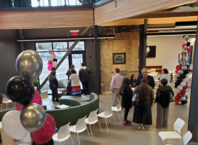
By Lee Egerstrom
An unusual and highly talented group of architects and designers have teamed up to start a first ever Indigenous Design Camp to introduce their professions to Minnesota Native youth.
The week long camp will begin on Monday, July 29 with morning classes at Dunwoody College of Technology in Minneapolis followed by afternoon field trips to architectural and design firms and to recently constructed building sites.
In announcing the program, the backers said it was designed “to ignite the spark of design creativity in Indigenous youth” who are ages 14 to 18. Word spread fast. The program was designed for 24 students and already had a wait list by the end of May.
Native Americans have long been known for contributions to various forms of art but are woefully under-represented in architecture, interior design, landscape architecture and related fields of planning and construction.
The Indigenous Design Camp is largely the creation of Mike Laverdure, a founding partner in the DSGW Architecture firm that has offices in Duluth, Virginia and the Twin Cities metro area. Laverdure works out of the Lake Elmo metro office and with his related First American Design Studio. He is a member of the Turtle Mountain Band of Ojibwe.
While design and architecture engage the arts, they are also important STEM (science, technology, engineering and math) careers, Laverdure said. It is the latter connections that have probably presented barriers to Indigenous youth, he said.
Math is at least helping bring awareness, he said. It has Native Americans and professional designers “rounding up, not rounding down,” he said.

In the past, census reports on the professions showed no Native Americans in the fields of architecture and design. Now, he said, Native Americans in these professions are “rounded up to 1 percent.”
But that is only statistical progress. Laverdure said he reached out to other architects and designers who he knew to be Native Americans and “allies” who want to help attract Indigenous youth to their work. Among these Indigenous professionals and allies, who Laverdure calls “co-captains,” are a mix of people from related fields and educators.
They include cohorts at DSGW, such as Navajo intern colleague Victor Pascual. Others include Dale Mulfinger, a founding partner of SALA Architects in Minneapolis, a former University of Minnesota faculty member and author of books about cabins; Sam Olbekson, from Full Circle Planning and Design in Minneapolis; Bartlett “Bake” Baker from McGough Companies, St. Paul; and professionals from the First American Design Studio and Minnesota Architectural Foundation.
Educators include Trevor Bullen, originally from the Caribbean, who is dean of the School of Design at Dunwoody College of Technology. He directs Dunwoody’s programs in architecture, interior design and graphic design.

Another key member of the group is Jessica Garcia Fritz, assistant professor in the University of Minnesota’s School of Architecture and the College of Design. She is a member of the Cheyenne River Sioux Tribe.
The Circle asked her why architecture and design careers remain largely out of reach for young indigenous people. Her response was a precise, classroom-like analysis:
“Euro-centric art and architecture have largely focused on the contributions of individual authorship. It’s the myth of the lone genius—the single individual who conceives of a building, a drawing, a painting, writing. etc. Their names are what we are asked to memorize in school and some are elevated to the ‘starchitect’ status.
“What this myth leaves out are collective forms of art making that are passed down generation to generation. In architecture, it’s the laborers both architectural and construction laborers, who are typically left out from the story of a building or the ‘built’ environment. The myth has also excluded marginalized people, especially in the US, where the profession was previously seen as a ‘gentleman’s profession’. This left architecture and design largely out of reach.
“Professions like architecture are now coming to terms with this history. The ‘built’ environment is too big to be left in the hands of a single group of people. Consider the Twin Cities. Many of us are still living in decisions made in the nineteenth and twentieth centuries, from the way our city is laid out to the buildings we live in. More diverse groups of people are entering into architecture and pushing practices to be more collective and collaborative.
“While lack of opportunity may have been the previous barrier, current barriers include funding, limited representation in school (especially for native people), and in many cases, having to leave a community to attend school.
“This is what is exciting about the Indigenous Design Camp – it’s led by indigenous people and is for indigenous people. We see it as a way to begin to address some of the challenges and barriers that have kept us from decision-making in the built environment.”
Given that background analysis, The Circle asked Garcia Fritz how she was drawn into the profession. Her response was definitely rooted in her Upper Midwest, Great Plains culture and environment.
“I came to architecture through art and construction,” she said. “I didn’t know that much about architecture when I started school. In fact, I started school at the University of Minnesota in biology.”
That was after graduating high school in the Bismarck/Mandan area and initially working in construction. “I was a roofer, I started out as an ‘unskilled laborer’ ripping off old roofs and throwing shingles to the crew. Eventually, I got to cut the shingles and use the nail gun, which is when I felt genuine trust. We worked on several public buildings including roofing the Mandan water works, next to Mni Sose (Missouri River), and buildings for the North Dakota State Penitentiary. Although it was short, I learned a lot from the people I worked with and consider them to be teachers in my education.”
At the university, she said, she deviated and took a couple of drawing classes that she enjoyed. They were a departure from her specialized biology classes.
“When I decided to go into architecture, it was because I could combine practical construction skills and ways of thinking about the world through drawing and writing,” she said.
In her case, experiences linked nicely with her talents. That is a goal for Indigenous Design Camp, Laverdure said.
The camp this year is just a start, he said. The core group is already making plans to expand the camp next year to include young native students from the Dakotas and surrounding states. And down the road, he said, the planners would like to make this a nationwide “adventure” for a prospective, potential, new generation of architects and designers.
For more information on the camp, see: https://www.aia-mn.org/event/indigenous-design-camp.






